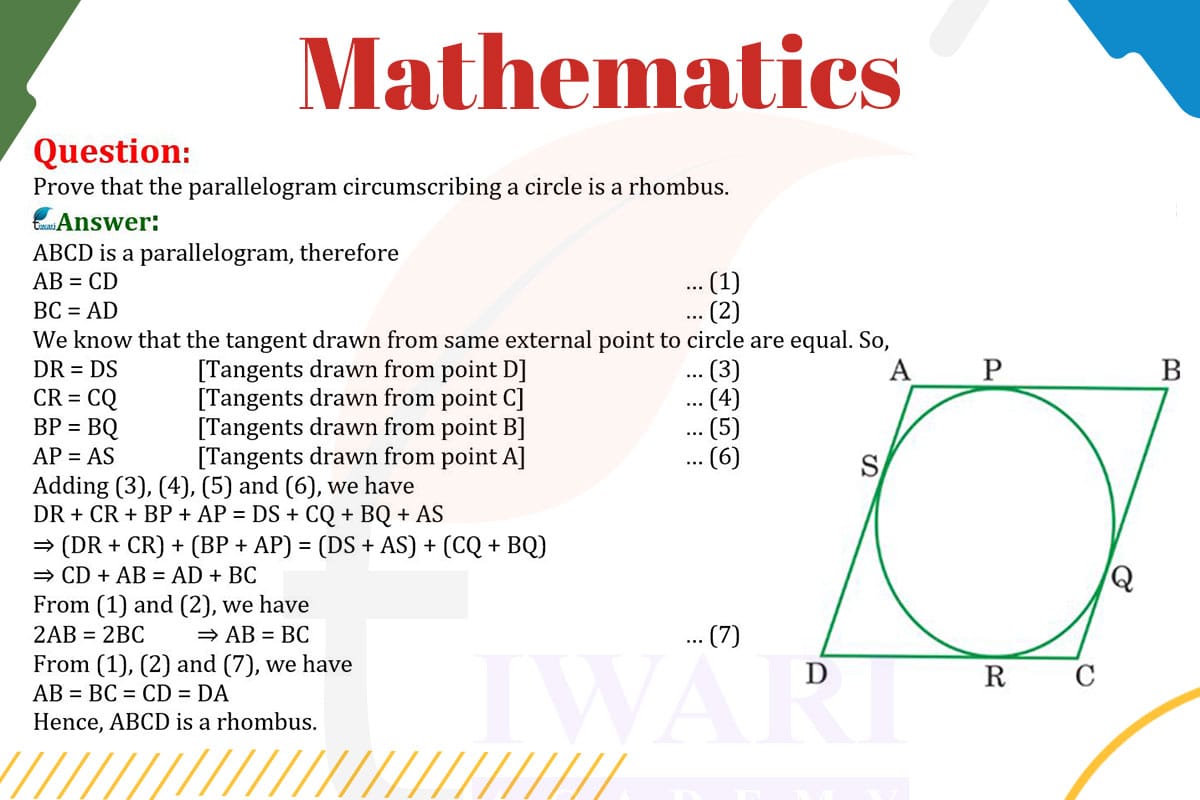To prove that a parallelogram circumscribing a circle is a rhombus:
Tangents from a Point: In a parallelogram ABCD circumscribing a circle, each side of the parallelogram acts as a tangent to the circle. Tangents drawn from a common external point to a circle are equal in length.
Equal Side Lengths: Therefore, AB = CD and BC = AD, as they are tangents from the vertices of the parallelogram to the circle.
Opposite Sides of Parallelogram: In a parallelogram, opposite sides are equal. Hence, AB = CD and BC = AD by the parallelogram’s properties as well.
Combining Properties: Combining the properties of tangents and parallelograms, all four sides of the parallelogram are equal.
Definition of Rhombus: A quadrilateral with all four sides equal is a rhombus.
Conclusion: Therefore, a parallelogram circumscribing a circle must be a rhombus.
This proof demonstrates that the unique properties of tangents and parallelograms necessitate that a parallelogram circumscribing a circle is always a rhombus.

Let’s discuss in detail
Introduction to Parallelograms and Circles
In the realm of geometry, the study of shapes and their properties often leads to intriguing conclusions. A fascinating case is the relationship between parallelograms and circles, particularly when a parallelogram circumscribes a circle. The theorem that any parallelogram circumscribing a circle is a rhombus is a perfect example of this. This theorem not only highlights the elegance of geometric principles but also showcases the interplay between different geometric figures.
Understanding the Parallelogram Circumscribing a Circle
A parallelogram circumscribing a circle means that the circle touches all four sides of the parallelogram. In this configuration, each side of the parallelogram acts as a tangent to the circle. This is crucial because tangents from a common external point to a circle have a unique property – they are equal in length. This property forms the basis of our proof that the parallelogram is a rhombus.
Tangents and Their Properties
The key to this proof lies in understanding the properties of tangents to a circle. A tangent to a circle is a line that touches the circle at exactly one point. Importantly, tangents drawn from the same external point to a circle are of equal length. In the context of our parallelogram, this means that opposite sides, being tangents from the vertices of the parallelogram to the circle, are equal in length.
Parallelogram Properties
In a parallelogram, by definition, opposite sides are equal in length. This is a fundamental property of parallelograms and is independent of the presence of a circumscribed circle. Therefore, in our parallelogram ABCD, AB is equal to CD, and BC is equal to AD simply because it is a parallelogram.
Combining Tangent and Parallelogram Properties
When we combine the properties of tangents and parallelograms, we find that all four sides of our parallelogram are equal. The tangent property ensures that each pair of opposite sides (AB and CD, BC and AD) are equal because they are tangents from the vertices to the circle. The parallelogram property also asserts that these sides are equal. Therefore, all four sides of the parallelogram must be of equal length.
The Parallelogram is a Rhombus
Since all four sides of the parallelogram are equal, by definition, the parallelogram is a rhombus. A rhombus is a quadrilateral with all sides equal in length. This conclusion elegantly demonstrates how the properties of tangents and parallelograms interact to reveal deeper truths in geometry. Thus, any parallelogram that circumscribes a circle is necessarily a rhombus, showcasing the beautiful symmetry and consistency inherent in geometric principles.
Discuss this question in detail or visit to Class 10 Maths Chapter 10 for all questions.
Questions of 10th Maths Exercise 10.2 in Detail

